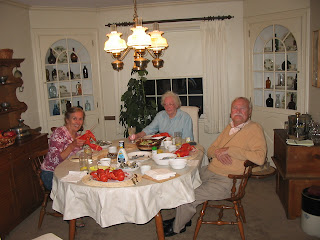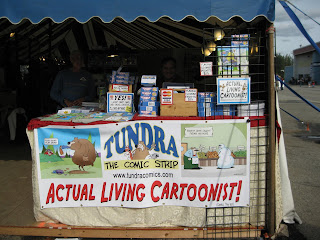Riverboat Discovery Cruise on the Chena River
Fairbanks was a very pleasant surprise. It is Alaska's second largest city, but has a population of only 33,000 people! The surrounding area has another 50,000+ people, however, which includes many Indigenous people and makes for a wonderful mix.
Other RV travellers had recommended that we take the Chena River trip on the stern wheeler, and it proved to be the perfect way to begin our visit.
Sled dogs at the kennel of Susan Butcher,
four-time winner of the 1,100 mile Iditarod Race.
From the ship we were given a demonstration of a bush pilot taking off and landing on the river. Then we stopped opposite the Johnson River Kennels and "chatted" with the staff over a mic system. We got to meet the puppies and watch a demonstration run by the dogs.
After that, we stopped and toured a typical old Chena Indian village. Our tour guide was a young Athabaskan woman named Jobeth. She was brought up with what she calls "the old ways", but is now attending the University of Alaska in Fairbanks and majoring in ecology.
Me with Jobeth at the Indian Village.
We walked from one area of the village to another learning about the life of the Athabaskans of interior Alaska. It was interesting to learn that different furs are used for different purposes. Thick moose hides make good blankets, and since the guard hairs on the outer caribou hides are hollow, their hides insulate the best and are often used for parkas. If I remember correctly, the "sun ray" around Jobeth's face is made of ermine fur which will not freeze and keeps the face protected.
The parka that Jobeth modeled costs a cool $20,000 !
We also found the fish camp interesting. There was a fish wheel there, and a drying rack and smoke house for salmon. It was explained that a dog eats one salmon a day during the winter, so it is no wonder that the local people take advantage of their fishing rights.
A fish wheel for catching salmon.
Salmon on drying racks.
Salmon in the smoke house.
For us, the other highlight in Fairbanks is the University of Alaska Museum of the North. The beautiful building dominated the campus. It was designed by a woman who wanted to capture the grandeur of the glaciers. Inside the building the sweep of the walls, the design of the staircases and all the interesting angles and corners integrated the structure of the building with the displays.
University of Alaska's Museum of the North.
I spent six delightful hours taking in the displays. I rented an audio guide so that I could hear wildlife calls, Alaska Native languages and details about the individual works that especially caught my eye. There was a wonderful variety... everything from classic Alaskan paintings, Eskimo clothing and ivory carvings, to a mummified prehistoric bison, and videos on the Bering Land Bridge, umiaks and whale hunting and the salmon life cycle.
Upstairs there is a small room called "The Place Where You Go To Listen". A single wide bench sits in the middle of the room and there are 16 speakers in the walls and in the ceiling. You are invited just to sit and listen. This is a unique sound-light environment created by composer John Luther Adams. "This ever-changing musical ecosystem gives voice to the rhythm of daylight and darkness, the phases of the moon, the seismic vibrations of the earth and the dance of the aurora borealis, in real time." He has somehow tapped into the sounds of the earth. What you hear is an ever-changing composition of the wind and the warmth of the sun and the groans of the earth. The colors on the walls change with the time of day. It was mostly yellow when I was first there, and then later in the afternoon a rich blue was creeping up from the floor. At times the sounds were light and musical and at times they were so deep they seemed to be coming from the belly of the earth. I enjoyed sitting there silently by myself. When I reluctantly left the room I wished that all the women in my Womens' Group could join me there, and be touched as I had been, by this connection to the sounds of the earth.

One of my favorite pieces ... caribou antlers and shadows.
The longer we stayed in Fairbanks, the more we liked it. Our campground , The Chena River State Park, was right at the edge of town and on the city bus line. One day we took the bus to the fairgrounds to attend the Tanana Valley State Fair. There were the usual rides and games, and the unusual ..... salmon crepes, fried halibut fish 'n chips, the Tundra cartoonist Chad Carpenter, and an agricultural display that would make your eyes pop.
The Tanana Valley State Fair.
Carpenter.... an actual living cartoonist!
The Blue Ribbon cabbage at the fair!
For us the whole town of Fairbanks was like a fair. We had such fun seeing the sights and talking to the people. It is a city by size but it feels like the Alaskan bush country. We learned that about half the homes do not have running water or indoor plumbing. We learned that many people depend on sled dogs or snow machines to get around in the winter. We learned that many of the people depend on subsistence rights and live off the land for most of their food. And yet.... they have created a lifestyle they would never trade. One woman told me that the minus 40 degree temperatures don't bother her. She even likes going out to her outhouse at night in the middle of the winter because it is sited so she can sit and admire the Aurora Borealis!
Ahhh, simple pleasures that brighten life ..... like giant sunflowers!





























































